Half a million kilometres in nine years, or, to be precise, 4,95,824km on the odometer. That’s the kind of mileage Jerusalem-based taxi driver Razi Saa’idi has clocked on his trusted and reliable W204 C-Class. On an average, Saa’idi, a slightly built man with close-cropped hair, drives 55,000km a year or 150km a day, which doesn’t seem like very much if you’re a taxi driver. But in a tiny country like Israel, which measures around 480km north to south and 140km east to west at its widest point, that sort of mileage is the equivalent of clocking 10,000 steps on a Fitbit in your living room. It also drives home the point that the best way to get around Israel is by road. You can reach any point of the country in less than a day; the roads are superbly paved and well-marked; and traffic is pretty sparse. For such a small country, you also get incredibly diverse landscapes, plenty of natural beauty, and thousands of years of history in the form of ancient sites. While most tourists flock to big cities such as Jerusalem and Tel Aviv, it’s the countryside that has more to offer.
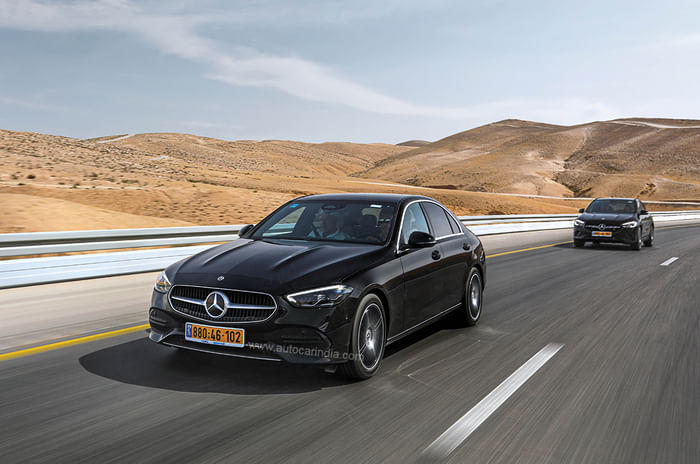
By now, you’ve figured that Israel is a great place for a road trip, and that’s exactly what we were there for – in two shiny black Mercs. Both the GLA and the C-Class we picked up from Eldan car rental at Tel Aviv airport were spanking new. Unlike Saa’idi’s C-Class, the one I had was the brand-new W206 model, which has just been launched in India, with only 23km on the clock. The plan was to drive both cars in tandem across the country, sticking to a pre-defined route and schedule curated by our hosts, Israel’s Ministry of Tourism.
The direct Air India flight from Delhi lands in Tel Aviv at night, so it was past 11pm by the time we got the keys to our cars from the courteous and patient Eldan staff. Our first stop was Jerusalem, less than an hour away, and this short drive in light traffic got us settled into the C-Class and GLA, and adjusted to driving on the right (wrong for us) side of the road.
 The night is always young in the resort town of Eilat.
The night is always young in the resort town of Eilat.
Driving in Israel is like driving anywhere in the West. Traffic is orderly and drivers are disciplined, and the roads, while not as wide as in bigger western countries, are, as mentioned earlier, perfectly paved. Google Maps works well in Israel, but we were told that Waze, founded in Israel and acquired by Google in 2013, is an even better navigation app. For this short run, though, we simply followed the driver of our support van who took us to a parking lot a short walk away from the charming Arthur Hotel, bang in the centre of Jerusalem.
 Old City scenes: An Orthodox Jew reads a prayer book.
Old City scenes: An Orthodox Jew reads a prayer book.
The following morning, we, like millions before us, were drawn towards the Old City, which can be explored only on foot. Jerusalem is many things to many people, but it is, above all, a city of intense faith that sits atop many layers of history. You get an intimation of its sanctity the moment you enter the Old City through the massive doors of the Jaffa Gate.
 Network of narrow alleyways connect different quarters of the city.
Network of narrow alleyways connect different quarters of the city.
The walled city, marked by narrow alleys and colourful bazaars, houses the Christian, Jewish, Muslim and Armenian Quarters – and sites that are central to the three Abrahamic faiths: Judaism, Islam and Christianity. These include the Temple Mount, once home to the First and Second Jewish Temples; its western support wall, The Western Wall or ‘Wailing Wall’, the last remnant of the original supporting wall of the Second Temple; the Al-Aqsa Mosque, the third holiest in Islam; and the gold-plated Dome of the Rock, a late 7th century CE shrine and the oldest extant Islamic monument. Keep walking on paved streets smoothened by the feet of both conquerors and pilgrims, and you hit the Church of the Holy Sepulchre, identified as the place of both, the crucifixion and tomb of Jesus Christ. Amid this agglomeration of holy sites, life carries in the Old City as it has done for centuries. Children hurry to school, the busy hum of commerce animates the bazaars, and there’s hummus to be had for lunch.
 Parking relatively easy to find in Jerusalem, as along the Haas Promenade that afforded a panoramic view, with a shimmering Dome of the Rock.
Parking relatively easy to find in Jerusalem, as along the Haas Promenade that afforded a panoramic view, with a shimmering Dome of the Rock.
We ended the day with a drive up to the Haas Promenade for a spectacular view of this photogenic city. The half empty parking lot alongside the promenade provided a great location for a photo-op of the C-Class, with the Dome of the Rock shimmering in the setting sun. Speaking of parking, we were pleasantly surprised at how easy it was to find a place to park everywhere we went. Sure, parking in the city centres is difficult, but not as painful as in other countries. In fact, we never had a problem finding a spot – and that is a big plus when you are on a road trip.
HIGHS AND LOWS
A 5am start allowed us to quickly escape a sleeping Jerusalem. The day, a long one, would end at the shores of the Dead Sea. The drive to our destination wasn’t a straight one, though, and a rambling detour off the main highway and into the biblical wilderness of the Judean desert took us to St George’s Monastery. The Greek Orthodox monastery, built around the 5th century CE and tucked away in a deep gorge called Wadi Qelt, is a cliff-hanger of a complex carved into a sheer rock wall. It’s so off the beaten track that we met only a handful of tourists (two of them from Kerala, incidentally), who, along with us, gamely braved the final stretch, a gruelling, vertiginous 1.5km walk to reach the gates of the monastery.
 Narrow, twisty sliver of tarmac leading to Saint George’s Monastery provided salvation of a different kind.
Narrow, twisty sliver of tarmac leading to Saint George’s Monastery provided salvation of a different kind.
The narrow, twisty and lonely sliver of tarmac that took us close to the monastery was a driver’s delight. It reminded me of how good the C-Class’ steering is, as I flicked the sedan from corner to corner, happy to oblige every time our cameraman Anand Malepu requested for “one more pass, please!” It’s easy to lose track of time when you are having fun and we were running an hour behind schedule, so we beat a hasty retreat to Route 90, which would take us straight to the Dead Sea.
You can’t miss the big Sea Level indicator on your drive from Jerusalem to the Dead Sea. There’s ample space for you to jump out for a photo-op with a camel that appears to have taken up permanent residence there. From here, it’s like driving down a giant bowl. The road gradually descends all the way to the Dead Sea, with several markers along the way showing your altitude dropping, below sea level, of course.
 420 metres to go before we get to the lowest point on Earth.
420 metres to go before we get to the lowest point on Earth.
We soon got our first glimpse of the Dead Sea shimmering in the distance. The bluish-green body of water, surrounded by golden brown hills, leaps out of the haze. Stepping out of the car to take a photograph, I’m struck by the searing heat. Just the way temperatures drop as you climb above sea level, it gets hotter and hotter as you go below. Thankfully, the C-Class’s air con kept the cabin nice and chilly. Swimming in the Dead Sea, which is actually a salt lake bordering Jordan to the east and Israel to the west, is a must-do. Technically, you are not swimming but only floating, because the buoyancy, five times greater than any other sea, pushes you up like some giant hand lurking under water. It’s a surreal feeling floating in the slimy and extremely salty water, with your body half sticking out. You can actually read a magazine or a book without wetting it, and that is what I did for the cameras.
Another reason the Dead Sea should be on your bucket list is because it’s an incredible 420 metres below sea level, making it the lowest point on earth. And that actually gives you a big high.
GIVE ME RED
Eilat, at the southern tip of Israel, is a good 228km from the Dead Sea, which, by Israeli standards, is quite a long drive. I had switched to the GLA and the higher seating position the compact luxury SUV affords came in handy on an off-road detour we took later that day into the Yotvata Hai-Bar Nature Reserve, which breeds and nurtures endangered biblical animals and releases them into the surrounding Negev desert.
 Acacia trees in the Negev desert echo the African savanna.
Acacia trees in the Negev desert echo the African savanna.
You wouldn’t associate Israel with teeming wildlife – over 60 percent of the country is desert – and it’s true that it doesn’t have big cats or the variety of animals you find in India, but nonetheless it was a rare experience to drive through the reserve and have ostriches knocking on your windows and watch herds of Arabian oryx and white antelope lounging in the shade of Acacia trees, their pale skin reflecting the sun’s heat.
 The Yotvata Hai-Bar Nature Reserve is home to the Arabian oryx and curious ostriches.
The Yotvata Hai-Bar Nature Reserve is home to the Arabian oryx and curious ostriches.
Our route from the Dead Sea to Eilat passed through the Arava Valley and the road snaked up as we ascended the evocatively named Ma’ale Akrabbim (“The Scorpions’ Ascent”). This change in elevation made for some terrific driving roads that undulate and curve across the reddish coloured hills and rocky landscape. The GLA isn’t as hunkered down as the C-Class through fast sweeping bends, but it resolutely holds its line nonetheless, the taut chassis and accurate steering making it a car you can drive at speed with confidence. Since we are on the subject of speed, we didn’t spot too many police cars patrolling the country’s secure highways, but that doesn’t tempt Israeli drivers from straying too far above the 110kph limit on two-lane highways. On single-lane roads, the speed limit drops to 80kph. Quite honestly, when you are surrounded by spectacular landscapes, you’d rather soak it all in than put your foot down.
 Well-paved roads with light traffic encourage long and enjoyable stints behind the wheel in Israel.
Well-paved roads with light traffic encourage long and enjoyable stints behind the wheel in Israel.
We get our first view of the Red Sea as we crest a rise and gently descend into Eilat. A dash was made for the beach for a sunset shot with the Mercs and that earned us a picture-postcard finish to a long but exhilarating day. Israel has made the most of this 12km strip of coastline sandwiched between Jordan and Egypt. Eilat is sunny and lively and has a buzzing nightlife.
 A Manta ray glides by at the Coral World Underwater Observatory in Eilat.
A Manta ray glides by at the Coral World Underwater Observatory in Eilat.
There’s a lot to do in the resort town apart from gazing at the blue waters of the Red Sea, and this includes parasailing and scuba diving. And if you have companions in need of some shopping therapy, they will be glad to know that by virtue of being a free trade zone, Eilat is exempt from value-added taxes, which translates into significantly lower prices for goods than the rest of Israel.
ROCKS OF AGES
We headed northwards again from Eilat, taking several detours to discover less frequented treasures such as the Timna National Park. Breathtaking purple, red and brown hills usher you into Timna, about 30km from Eilat, and just off Route 90. Otherworldly rock formations, shaped by the wind over millions of years, give the park, one of Israel’s largest, a Martian vibe. This Grand Canyon of Israel is a geologist’s delight, with rocks shaped like mushrooms, majestic columnar formations such as ‘Solomon’s Pillars’, and the remnants of ancient copper mines.
 ‘Solomon’s Pillars’ and the Mercs at Timna Park: A million years apart but all shaped by the wind.
‘Solomon’s Pillars’ and the Mercs at Timna Park: A million years apart but all shaped by the wind.
The cherry on the cake was the fabulously empty and smooth roads inside the park. Some of these were dirt roads, so the low-slung C-Class was unwittingly forced into some off-roading. I was more than a little worried about the relatively low-pro tyres, especially when I dropped the outside wheels onto a shoulder with jagged stones while executing three-point turns for multiple passes for the camera. But the tyres did hold up quite well and, in fact, both cars got back home without a single puncture.
Timna might have made us crane our necks in awe to take in nature’s handiwork, but the sheer immensity of Makhtesh Ramon (the Ramon Crater) took a longer time to process. Makhtesh Ramon, 40km long and up to 10km wide, is an erosion crater and a landform unique to the Negev and Egypt’s Sinai desert, and, in fact, it took us a while to realise that we were driving through it. The road that led from Timna to Makhtesh Ramon featured gentle curves and sparse traffic, and the spectacular scenery all around made the journey even more exciting than the destination. The best bit was climbing out of the crater and getting to the visitors’ centre in the city of Mitzpe Ramon, the gateway to Makhtesh, to feast on fabulous views of the crater.
 Petrol pricey at the equivalent of Rs 164; diesel touches a stratospheric Rs 227.
Petrol pricey at the equivalent of Rs 164; diesel touches a stratospheric Rs 227.
Before we leave Mitzpe Ramon, we tank up both cars, as fuel stations in the region are far and few between. If you think petrol is expensive in India, it’s even more so in Israel, where a litre of 95 octane costs 7.06 shekels (about Rs 164), and diesel is at an even steeper 9.74 shekels (Rs 227.25). Thank god, we weren’t driving diesel cars! Both our petrol-powered Mercs were reasonably efficient and returned an overall figure of 15kpl, which is pretty decent given the terrain we were driving on.
 A road sign you’ll only find in Israel.
A road sign you’ll only find in Israel.
The heart of the Negev desert, through which we were travelling, also hosts military exercises, so besides camels, you also have to watch out for tanks crossing the road! The last bit of the day’s drive, down a hilly road, led to Kfar Hanokdim, a resort surrounded by the Judean desert and inspired by the culture and customs of the Bedouins.
 Scorpion-spotting in the Negev with UV light.
Scorpion-spotting in the Negev with UV light.
After dinner that night, we trooped out of our desert-style rooms and ventured out into the surrounding desert in search of scorpions, and discovered that these masters of camouflage light up like a reflective road sign under UV light. That’s right: scorpions are the only land-based creatures that glow bright green under a beam of ultra-violet light. Use an ordinary torch and these venomous arachnids are all but invisible. It was a classic case of now you see them, now you don’t.
RISE AND SHRINE
The scenery changes dramatically as we continue our journey further north. The austere beauty of the Negev recedes into the distance and is replaced by the soothing green of a Mediterranean countryside. According to an old Israeli saying, “In Jerusalem they pray, in Tel Aviv they party, in Haifa they work.” Haifa, one of Israel’s biggest port cities, might have a reputation for industriousness, but it is also immensely charming, with a laid-back Tuscan vibe. Situated on the western promontory of Mount Carmel, the city, much admired for its multiculturalism, unfurls magnificent views of the Mediterranean.
Haifa’s most popular attraction is the impeccably manicured and terraced Baha’i Gardens that roll down the slopes of Mount Carmel. Later that afternoon, after a quick lunch of some excellent falafel, we drove to the outskirts of the city to meet up with a group of classic car lovers who hang out with their cars every Saturday in a big parking lot. Car culture isn’t big in Israel, because, thanks to high import duties, good cars are unaffordable for most, but it’s not hard to find pockets of passionate (and rich) enthusiasts that are as mental – and as proud of the cars they own – as anywhere else. Shimon Rosenfeld, a mechanical engineer, is one of them. The octogenarian, an Auschwitz survivor, beamed with pride as we admired his impeccably maintained Mercedes-Benz S500 (W140), and told us, through an interpreter, about his other car, an NSU. And before we left, in a touching gesture, Rosenfeld treated us fellow enthusiasts to ice cream. Dinner that evening was at the La Cochina Douzan, a chic restaurant located in the trendy, tree-lined German Colony neighbourhood, and before we hit the sack that night, we admired some fabulous views of the illuminated Baha’i Gardens and Shrine through the large windows of our rooms at the elegant Schumacher Hotel (no connection to Michael or his family).
Early the next morning, we drove along the Mediterranean coast to Rosh Hanikra, which lies on the northernmost edge of Israel, within spitting distance of the border with Lebanon. Rosh Hanikra was once part of an old railway route that connected Israel (then the British Mandate) with Lebanon, but today it is more popular for its grottoes that were formed over thousands of years, as the sea and rain kept battering the bone-white limestone cliffs. You hop into a cable car, on the world’s shortest and steepest line, that takes you to a trail alongside the grottoes, where the sea rushes in and creates a grand theatre of sound and light. Acre, the last stop on our week-long journey, was a special one. Acre, a UNESCO World Heritage Site, is a walled city by the Mediterranean, studded with mosques, citadels and baths, and has been shaped by everyone, from the Romans and the Ottomans to the Byzantines and British. But the biggest imprint on the city has perhaps been left by the Crusaders. Acre was once a major Crusader stronghold, and the remains of the Crusader town, built between 1104 and 1291 CE, are still extremely well-preserved, both below and above street level. (Acre’s narrow lanes don’t make it car-friendly and it’s best to park your car in one of the secure government-run parking lots.) A quiet lunch, our last in Israel, at a homely local restaurant by the Mediterranean, provided me with an opportunity to mentally retrace our route over the last seven days. We had driven over 1,300km across Israel and discovered that its attractions extend way beyond the theological and that its canvas was a colourful one, filled with cerulean skies, dun-coloured deserts and striking blue seas. During our journey from Acre to the Tel Aviv airport, I learnt how to bid farewell in Hebrew, and while I still can’t get the pronunciation of ‘Ani hachzor shoov bekarov’ right, I mean it when I say that I’ll be back soon.
5 REASONS TO ROAD-TRIP IN ISRAEL
1. Israel’s spectacular scenery is complemented by a well-developed highway system with smooth roads and light traffic.
2. Most road signs in Israel are also written in English, so you know exactly where you are going.
3. Israel has both paid and free parking lots, and finding parking even in its major cities is not too much of a problem.
4. Of course, the Israelis have Waze, the world’s largest community-based traffic and navigation app, but just so you know, Google Maps works just fine, too.
5. Picking up a local prepaid SIM card in Israel is a fuss-free affair with minimal paperwork. Plus, good deals abound.
Holiest of the holy: Israel is home to sacred sites of 4 major religions
CHURCH OF HOLY SEPULCHRE
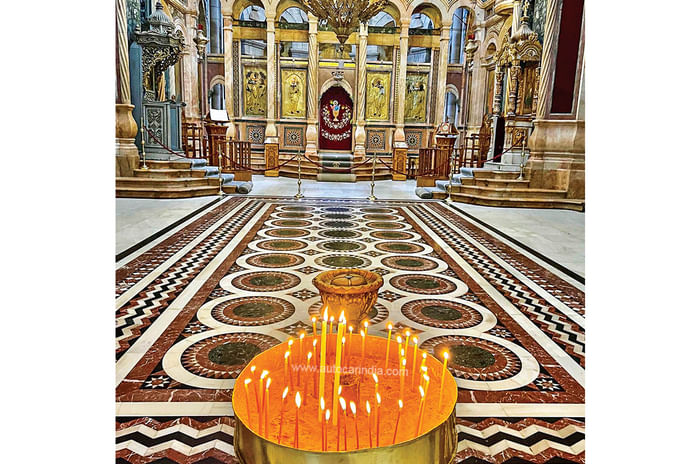
The Church of the Holy Sepulchre in Jerusalem, a large architectural complex featuring several small chapels, was first constructed in around 326 CE, and is sacred to all Christian faiths. The large structure, which has seen several alterations and additions over the centuries, houses different Christian denominations such as the Catholic church, the Armenian church and Syrian Orthodox church. Christians believe the site was one where Jesus died, was buried and was resurrected.
DOME OF THE ROCK
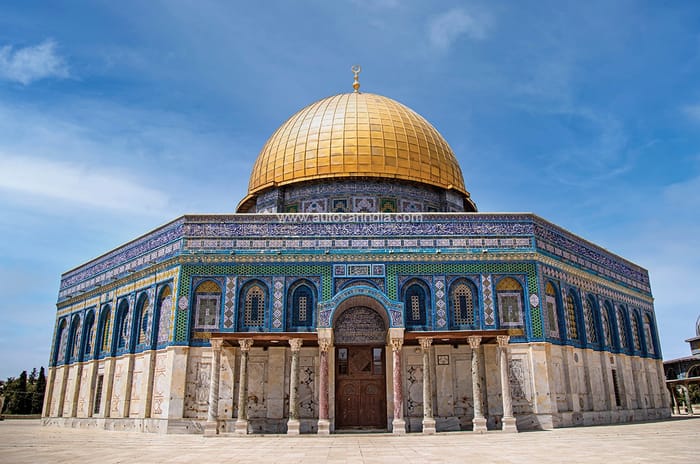
Jerusalem’s Old City is also home to a complex of religious structures known to Muslims as al-Haram al-Sharif (‘The Noble Sanctuary’) and to Jews as the Temple Mount. The Dome of the Rock, a 7th century shrine located within the complex, is one of the oldest extant Islamic monuments. The shrine is built over a sacred stone, from which, Muslims believe, Prophet Muhammad ascended to heaven, while to Jews, the rock is the very place where Abraham prepared to sacrifice Issac. The Al-Aqsa Mosque is located in the same complex and is the third holiest site in Islam, after Mecca and Medina.
THE WESTERN WALL
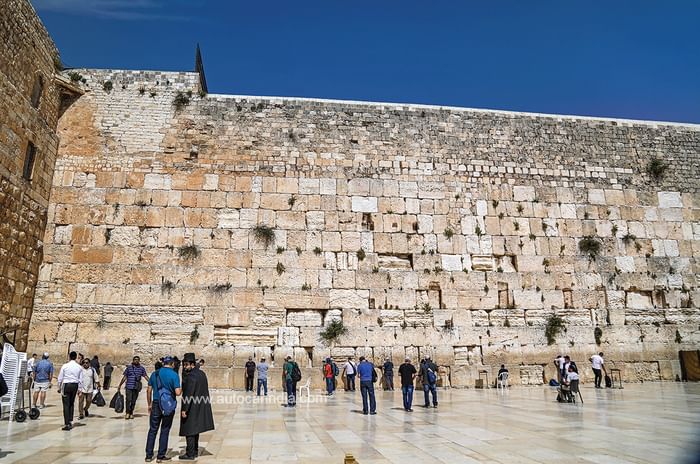
The Western Wall (also called Wailing Wall) is located in the Jewish Quarter in Jerusalem, and is one of the last remaining walls that once surrounded the Temple Mount, the site of the First and Second Temples of Jerusalem. The Second Temple was destroyed by the Romans in 70 CE. The Western Wall, one of Judaism’s holiest sites, is visited each year by millions of people who insert prayers, hand-written on scraps of paper, into cracks in the Wall.
THE BAHA’I GARDENS
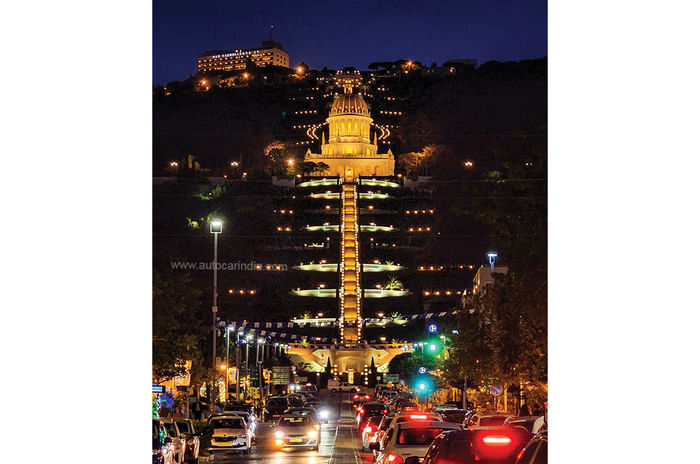
Israel is not just integral to ancient religions. Up north, the port city of Haifa is home to the relatively new Baha’i faith, a religion born in Iran in 1844. The Baha’i Gardens is a study in symmetry, and home to the gold-domed shrine of the Bab, which contains the tomb of Siyyid Ali Muhammad, the forerunner of the Baha’i revelation. In Acre, further up the coast, you’ll find the resting place of Bahaullah, the prophet-founder of the Baha’i faith.


























